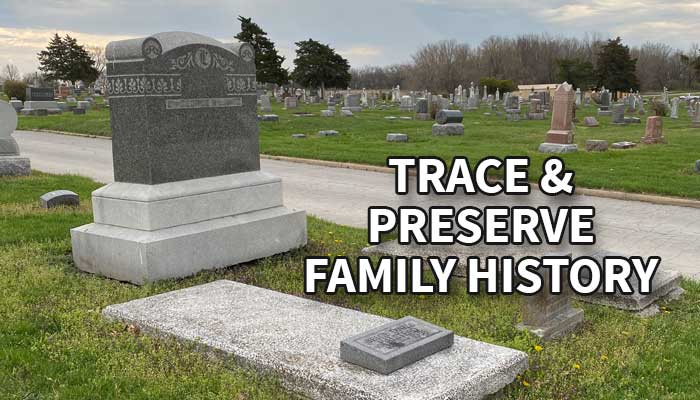Online ancestry databases make it easier than ever to trace family history. Sites like ancestory.com provide a wealth of information about families and where they came from. Yet there’s nothing like actually visiting the burial sites of your ancestors. Grave monuments preserve a family’s story in stone. Here’s how to use grave headstones to trace and preserve your family’s history.
Using Memorials to Trace Your Family’s History
Visiting ancestral burial sites can be fun! The first half of the 20th century and prior, most people were buried very near where they lived. Many immediate and extended family members are likely buried nearby.
Family History – More Than Names and Dates
Walking among the burial sites, visiting the memorials, and visiting the community and area where your ancestors lived is walking where they walked and lived.
Try seeing the land and community through their eyes. Notice the dates on the headstones around your family’s graves. How long did they live? Did they live through a war? A pandemic? Did some of them die in a war, pandemic, or in childbirth? How many children are buried nearby? What was happening in the area where they lived at the time? How did they arrive at the area where they lived and died?
What are some of the stories of your family’s adventures and struggles that have been passed down to you? Imagine what life was like for them. Look around and think about how difficult travel would be on horseback or in a wagon over rough terrain. Consider if there were native people unhappy about your ancestor’s arrival and the struggles that created.
Simple Ways to Preserve Your Ancestor’s Gravestone History
Take Photos and Videos
Use your cell phone to take photographs of your family’s memorials. Videos of the burial sites and your impressions about the way they lived in the area are also valuable. Save these photos and videos on a stick drive.
Make prints of the photographs and place them in long-term storage or archival-quality scrapbooks. This will preserve the prints and information on the monuments for future generations. Don’t depend on digital copies of photos and videos. Technology changes quickly. Eventually, the digital copies will be too old to be viewed on the current equipment of the day.
Create Headstone Rubbings
Some monuments are so old that the engraving is worn and difficult to read. In this instance, a rubbing might be useful for recording the information.
First, be sure the headstone is strong enough for you to make a rubbing without causing damage. If it’s cracked, flaking badly, or wobbly, then don’t try making a rubbing.
Next, carefully clean any dirt, moss, or bird droppings from the monument. Follow the instructions for cleaning a monument before starting.
Supplies Needed to Make a Headstone Rubbing
- Cleaning supplies (if needed)
- Scissors
- White easel paper
- Black crayons or block wax crayons
- Lightly tack masking tape
- Poster tube
- Rubber band
How to Make a Headstone Rubbing
- Carefully tape the paper across the front of the monument. Do not tape over areas where the monument is flaking.
- Using the long side of the crayon or large, flat front of the wax rubbing block, gently begin rubbing across the paper starting at the outer edges working your way in. Keep rubbing until the image is visible.
- When you finish your rubbing, carefully remove the tape from the monument. Don’t leave behind any tape on the monument.
- Roll the paper your rubbing is on and secure it with a rubber band.
- Place your rubbing in a poster tube to protect it.
Here’s a handy link to a YouTube video showing how to make a headstone rubbing.
You may want to frame your headstone rubbing and display it on a wall or take a photograph of it to preserve in your family history scrapbook.
Preserving Your Own Family’s History on Your Monument
Now more than ever a monument tells your family’s story.
Current technology makes it possible to not only include names, dates, and other wording on a monument but to include a portrait of the person memorialized. Images of a person’s lifestyle, loves, hobbies, and more can be included on a monument.
When planning your monument, consider future generations’ desire to trace their genealogy. Include on your memorial the date of your marriage and the names of your children, even grandchildren. Add images of how you lived.
A farmer can include an image of a tractor or of the livestock he raised.
A seamstress can add an image of a sewing machine.
Gardeners can include images of flowers, gardening tools, Mason jars, etc.
Car, motorcycle, music enthusiasts can share their passions with future generations by including images reflecting the things that are important to them.
The possibilities are endless.
Do you have questions about finding burial sites? Would you like more information about creating a memorial for yourself that reflects who you are to share with future generations?
Please give us a call. We’re here to help you.



